Diversity and Functional Distribution Characteristics of Myxobacterial Communities in the Rhizosphere of Tamarix chinensis Lour in Ebinur Lake Wetland, China
Abstract
:1. Introduction
2. Materials and Methods
2.1. Research Location
2.2. Soil Physicochemical Properties
2.3. Soil DNA Extraction
2.4. Data Processing and Analysis
3. Results
3.1. Temporal and Spatial Distribution of Myxobacterial Communities in the Rhizosphere of Tamarix chinensis Lour in Ebinur Lake Wetland
3.1.1. Genus Level Composition of Myxobacteria Community
3.1.2. Diversity of Myxobacteria in the Rhizosphere of Tamarix chinensis Lour in Ebinur Lake Wetland
3.1.3. Functional Diversity of Myxobacteria in the Rhizosphere of Tamarix chinensis Lour in Ebinur Lake Wetland
3.2. Association between the Diversity of Sticky Bacteria and Bacterial Diversity in the Rhizospheres of Tamarix chinensis Lour in Ebinur Lake Wetland
3.2.1. Correlation between the Diversity Indexes of Myxobacteria and Bacteria
3.2.2. Function and Bacterial Diversity of Myxobacteria of Tamarix chinensis Lour Rhizospheres in Ebinur Lake Wetland
3.2.3. Interactions between Myxobacteria and Bacterial Community Network of Tamarix chinensis Lour Rhizospheres in Ebinur Lake Wetland
3.3. Correlation between Rhizosphere Myxobacteria and Soil Physicochemical Factors of Tamarix chinensis Lour in Ebinur Lake Wetland
4. Discussion
4.1. Community Structure and Functional Distribution of Myxobacteria in the Rhizosphere of Tamarix chinensis Lour in Ebinur Lake Wetland
4.2. Response of Myxobacteria Community to Biological Factors
4.3. Response of Myxobacterium Communities to Abiotic Factors
5. Conclusions
Supplementary Materials
Author Contributions
Funding
Data Availability Statement
Conflicts of Interest
References
- Bauhus, J.; Paré, D.; Coté, L. Effects of tree species, stand age and soil type on soil microbial biomass and its activity in a southern boreal forest. Soil Biol. Biochem. 1998, 30, 1077–1089. [Google Scholar] [CrossRef]
- Xiao, F.; Li, Y.; Li, G.; He, Y.; Lv, X.; Zhuang, L.; Pu, X. High throughput sequencing-based analysis of the soil bacterial community structure and functions of Tamarix shrubs in the lower reaches of the Tarim River. PeerJ 2021, 9, e12105–e12123. [Google Scholar] [CrossRef] [PubMed]
- Xing, L.M.; Li, Q.; Gao Yuan, Q.H.; Li, N. Effect of different phosphorus supply levels on rhizosphere microbial functional diversity of Medicago sativa. Plant Ecol. Process. 2022, 39, 1496–1503. [Google Scholar] [CrossRef]
- Wu, C.H.; Liu, J.Z. Research Progress on Influencing Factors of Rhizosphere Microorganisms and Their Interaction with Plants. J. Hebei Norm. Univ. 2022, 46, 603–613. [Google Scholar] [CrossRef]
- Bull, C.T.; Shetty, K.G.; Subbarao, K.V. Interactions Between Myxobacteria, Plant Pathogenic Fungi, and Biocontrol Agents. Plant Dis. 2002, 86, 889–896. [Google Scholar] [CrossRef] [Green Version]
- Zhou, X.W.; Li, S.G.; Li, W.; Jiang, D.M.; Han, K.; Wu, Z.H.; Li, Y.Z. Myxobacterial community is a predominant and highly diverse bacterial group in soil niches. Environ. Microbiol. Rep. 2014, 6, 45–56. [Google Scholar] [CrossRef]
- Dai, W.; Liu, Y.; Yao, D.; Wang, N.; Ye, X.F.; Cui, Z.L.; Wang, H. Phylogenetic diversity of stochasticity-dominated predatory myxobacterial community drives multi-nutrient cycling in typical farmland soils. Sci. Total Environ. 2023, 871, 161680–161692. [Google Scholar] [CrossRef]
- Dai, W.; Wang, N.; Wang, W.; Ye, X.F.; Cui, Z.L.; Wang, J.L.; Yao, D.; Dong YHWang, H. Community Profile and Drivers of Predatory Myxobacteria under Different Compost Manures. Microorganisms 2021, 9, 2193. [Google Scholar] [CrossRef]
- Wang, C.L.; Lv, Y.; Li, A.Z.; Yao, Q.; Feng, G.D.; Zhu, H.H. Culture-dependent and -independent methods revealed an abundant myxobacterial community shaped by other bacteria and pH in Dinghushan acidic soils. PLoS ONE 2020, 15, 238769–238782. [Google Scholar] [CrossRef]
- Ye, X.; Li, Z.; Luo, X.; Wang, W.; Li, Y.; Li, R.; Zhang, B.; Qiao, Y.; Zhou, J.; Fan, J.; et al. A predatory myxobacterium controls cucumber Fusarium wilt by regulating the soil microbial community. Microbiome 2020, 8, 49. [Google Scholar] [CrossRef] [Green Version]
- Wang, W.H.; Wang, N.; Dang, K.; Dai, W.; Guan, L.; Wang, B.; Gao, J.S.; Cui, Z.L.; Dong, Y.H.; Wang, H. Long-term nitrogen application decreases the abundance and copy number of predatory myxobacteria and alters the myxobacterial community structure in the soil. Sci. Total Environ. 2020, 708, 135114–135169. [Google Scholar] [CrossRef] [PubMed]
- Wang, K.; Jia, R.; Li, L.N.; Jiang, R.; Qu, D. Community structure of Anaeromyxobacter in Fe (III) reducing enriched cultures of paddy soils. J. Soils Sediments 2020, 20, 1621–1631. [Google Scholar] [CrossRef]
- Wang, W.H.; Luo, X.; Ye, X.F.; Chen, Y.; Wang, H.; Wang, L.; Wang, Y.B.; Yang, Y.Y.; Li, Z.K.; Cao, H.; et al. Predatory Myxococcales are widely distributed in and closely correlated with the bacterial community structure of agricultural land. Appl. Soil Ecol. 2020, 146, 103365–103375. [Google Scholar] [CrossRef]
- Liu, T.; Wang, Y.H.; Abrimiti, A. The relationship between different salt crust thickness and soil physical properties in Ebinur Lake wetland and its influencing factors. Acta Sci. Nat. Univ. Sunyatseni 2021, 60, 91–101. [Google Scholar] [CrossRef]
- Lin, Q.; Chen, M.; Wang, Y.C.; Ding, D.F.; Luo, Q.L.; Yang, J.M. Study on ecological water demand of Aibi lake basin based on ecological restoration. Water Resour. Plan. Des. 2022, 7, 14–18. [Google Scholar]
- Cheng, J.J.; Zheng, X.N.; Zhang, Z.Y.; Chen, J. Analysis on differences in leaf functional traits of desert plants under interspecific association pattern in different water-salt environments of Ebinur Lake. J. Plant Resour. Environ. 2022, 31, 18–25. [Google Scholar]
- He, X.P.; Wang, B.D.; Xie, L.P. Effects of Tamarix on ecoloaical environment of saline-alkali soils. Mar. Sci. 2014, 38, 96–101. [Google Scholar]
- Wang, W.H.; Wang, H.; Feng, Y.Z.; Wang, L.; Xiao, X.J.; Xi, Y.G.; Luo, X.; Sun, R.B.; Ye, X.F.; Huang, Y.; et al. Consistent responses of the microbial community structure to organic farming along the middle and lower reaches of the Yangtze River. Sci. Rep. 2016, 6, 35046–35057. [Google Scholar] [CrossRef] [PubMed] [Green Version]
- Xu, X.J.; Cao, C.Y.; Cui, Z.B.; Yang, M. Comparison of the methods for extracting and purifying microbial total DNA from an aeolian sandy soil. Ying Yong Sheng Tai Xue Bao 2010, 5, 1327–1333. [Google Scholar] [PubMed]
- Beller, H.R.; Han, R.; Karaoz, U.; Lim, H.; Brodie, E.L. Genomic and physiological characterization of the chromate-reducing, aquifer-derived Firmicute Pelosinus sp. strain HCF1. Appl. Environ. Microbiol. 2013, 79, 63–73. [Google Scholar] [CrossRef] [Green Version]
- Qiu, L.; Kong, W.; Zhu, H.; Zhang, Q.; Banerjee, S.; Ishii, S.; Sadowsky, M.J.; Gao, J.; Feng, C.; Wang, J.; et al. Halophytes increase rhizosphere microbial diversity, network complexity and function in inland saline ecosystem. Sci. Total Environ. 2022, 831, 154944. [Google Scholar] [CrossRef] [PubMed]
- Fudou, R.; Jojima, Y.; Iizuka, T.; Yamanaka, S. Haliangium ochraceum gen. nov., sp. nov. and Haliangium tepidum sp. nov.: Novel moderately halophilic myxobacteria isolated from coastal saline environments. J. Gen. Appl. Microbiol. 2002, 48, 109–116. [Google Scholar] [CrossRef] [Green Version]
- Li, Y.H.; Zhu, H.Q.; Fang, L.Z.; Li, F.D. Soil enzyme activity characteristics and impact factors under plant communities of the Ebinur Lake wetland. Acta Ecol. Sin. 2020, 40, 549–559. [Google Scholar] [CrossRef]
- Jiao, Y.Q. Research status of temporal and spatial variation of soil inorganic nitrogen (ammonium nitrogen, nitrate nitrogen). Mod. Salt Chem. Ind. 2022, 49, 20–22. [Google Scholar] [CrossRef]
- Chao TCKalinowski, J.; Nyalwidhe, J.; Hansmeier, N. Comprehensive proteome profiling of the Fe (III)-reducing myxobacterium Anaeromyxobacter dehalogenans 2CP-C during growth with fumarate and ferric citrate. Proteomics 2010, 10, 1673–1684. [Google Scholar] [CrossRef]
- Xia, S.H.; You, J.H.; Wang, B.L.; Qu, D. Effects of flooding time on anaerobic myxobacteria community structure of in paddy soil. J. Agric. Biotechnol. 2011, 19, 793–800. [Google Scholar]
- Masuda, Y.; Yamanaka, H.; Xu, Z.X.; Shiratori, Y.; Aono, T.; Amachi, S.; Senoo, K.; Itoh, H. Diazotrophic anaeromyxobacter isolates from soils. Appl. Environ. Microbiol. 2020, 86, e00956–e00968. [Google Scholar] [CrossRef]
- Wang, Y.J.; Huang, Q.; Gao, H.; Zhang, R.Q.; Yang, L.; Guo, Y.R.; Li, H.K.; Awasthi, M.K.; Li, G.C. Long-term cover crops improved soil phosphorus availability in a rain-fed apple orchard. Chemosphere 2021, 275, 130093–130103. [Google Scholar] [CrossRef] [PubMed]
- Pasternak, Z.; Pietrokovski, S.; Rotem, O.; Gophna, U.; Lurie-Weinberger, M.N.; Jurkevitch, E. By their genes ye shall know them: Genomic signatures of predatory bacteria. ISME J. 2013, 7, 756–769. [Google Scholar] [CrossRef] [PubMed] [Green Version]
- Morgan, A.D.; MacLean, R.C.; Hillesland, K.L.; Velicer, G.J. Comparative analysis of myxococcus predation on soil bacteria. Appl. Environ. Microbiol. 2010, 76, 6920–6927. [Google Scholar] [CrossRef] [Green Version]
- Jiao, S.; Chen, W.M.; Wang, J.L.; Du, N.; Li, Q.P.; Wei, G.H. Soil microbiomes with distinct assemblies through vertical soil profiles drive the cycling of multiple nutrients in reforested ecosystems. Microbiome 2018, 6, 146–159. [Google Scholar] [CrossRef] [Green Version]
- Kuklinsky-Sobral, J.; Araújo, W.L.; Mendes, R.; Geraldi, I.O.; Pizzirani-Kleiner, A.A.; Azevedo, J.L. Isolation and characterization of soybean-associated bacteria and their potential for plant growth promotion. Environ. Microbiol. 2004, 6, 1244–1251. [Google Scholar] [CrossRef]
- Wu, Y.N.; Jiang, B.W.; Zou, Y.; Dong, H.Y.; Wang, H.; Zou, H.F. Influence of bacterial community diversity, functionality, and soil factors on polycyclic aromatic hydrocarbons under various vegetation types in mangrove wetlands. Environ. Pollut. 2022, 308, 119622–119631. [Google Scholar] [CrossRef] [PubMed]
- Zhou, Y.; Zhang, X.J.; Yao, Q.; Zhu, H.H. Both Soil Bacteria and Soil Chemical Property Affected the Micropredator Myxobacterial Community: Evidence from Natural Forest Soil and Greenhouse Rhizosphere Soil. Microorganisms 2020, 8, 1387. [Google Scholar] [CrossRef]
- Zhou, J.; Deng, Y.; Zhang, P.; Xue, K.; Liang, Y.; Van Nostrand, J.D.; Yang, Y.; He, Z.; Wu, L.; Stahl, D.A.; et al. Stochasticity, succession, and environmental perturbations in a fluidic ecosystem. Proc. Natl. Acad. Sci. USA 2014, 111, E836–E845. [Google Scholar] [CrossRef] [PubMed]
- Wang, J.; Wang, J.N.; Wu, S.G.; Zhang, Z.; Li, Y.Z. Global Geographic Diversity and Distribution of the Myxobacteria. Microbiol. Spectr. 2021, 9, e00012–e00021. [Google Scholar] [CrossRef] [PubMed]
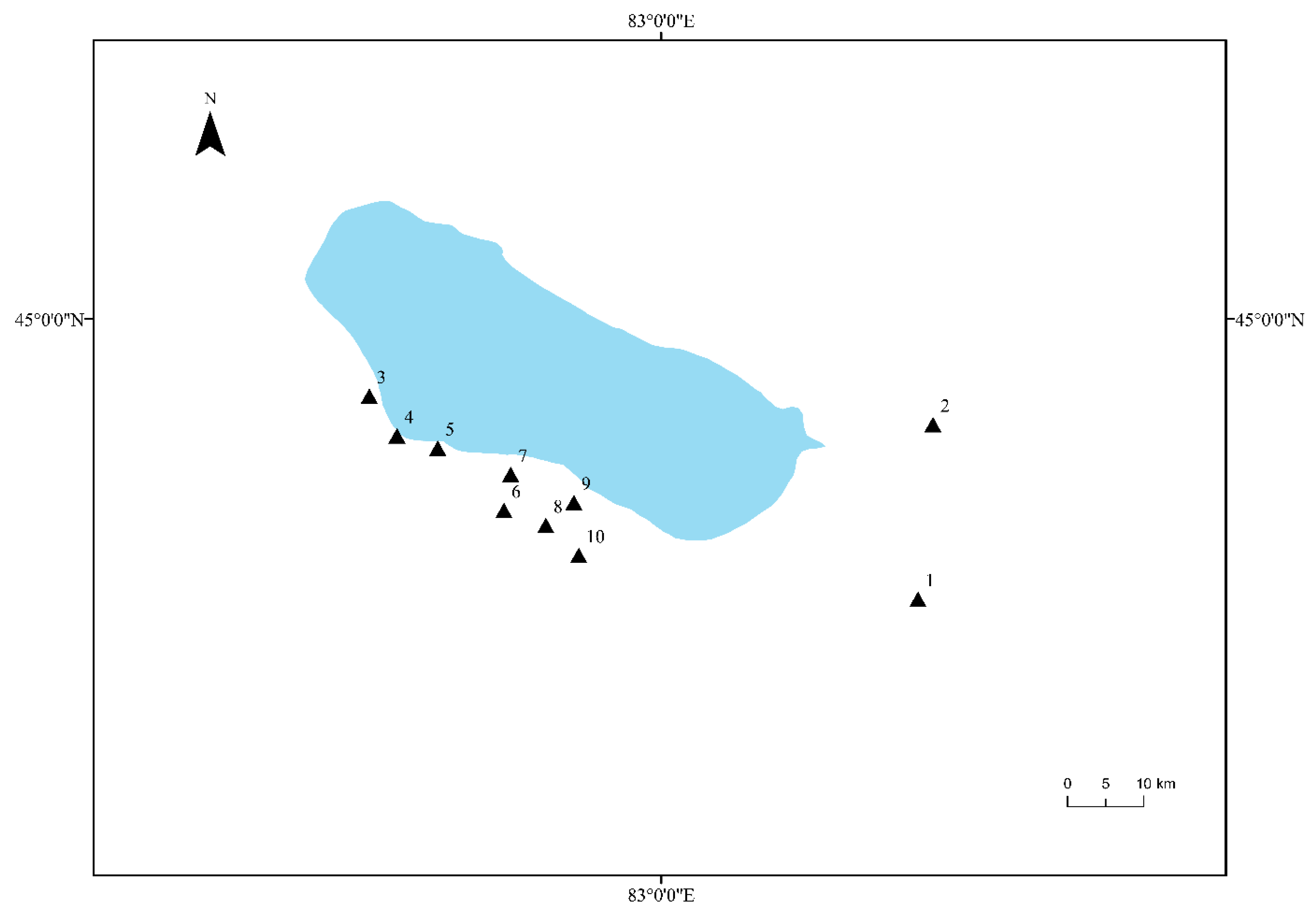
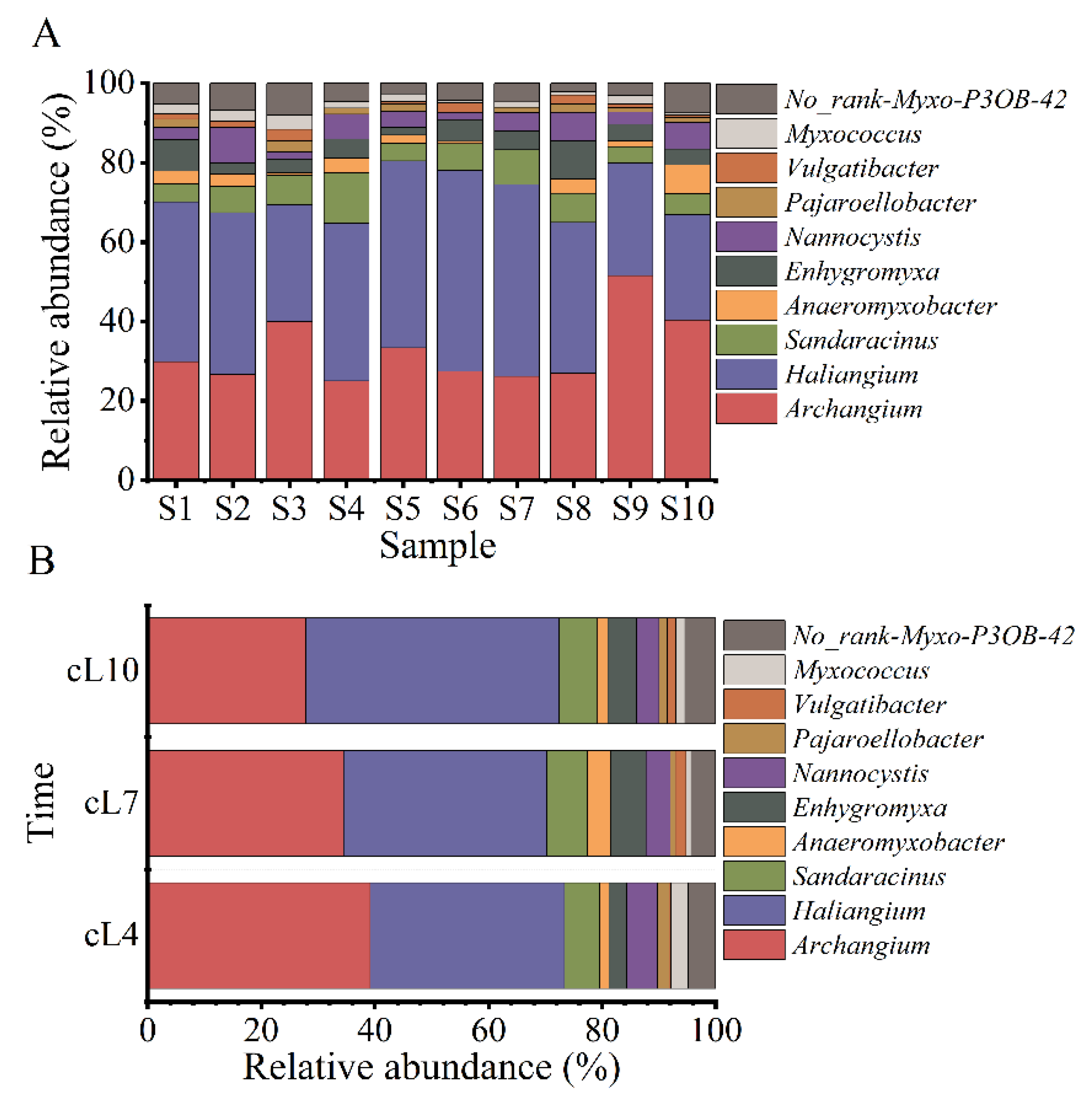
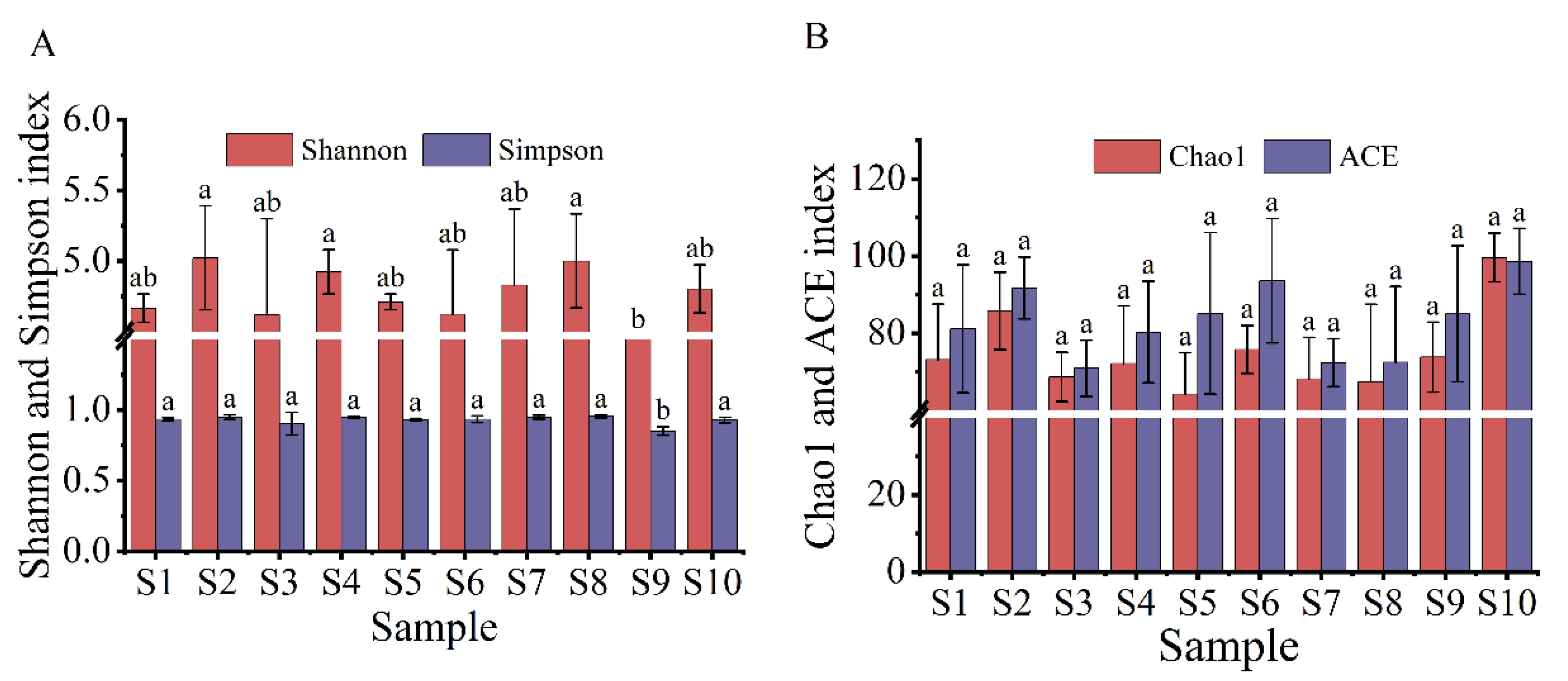

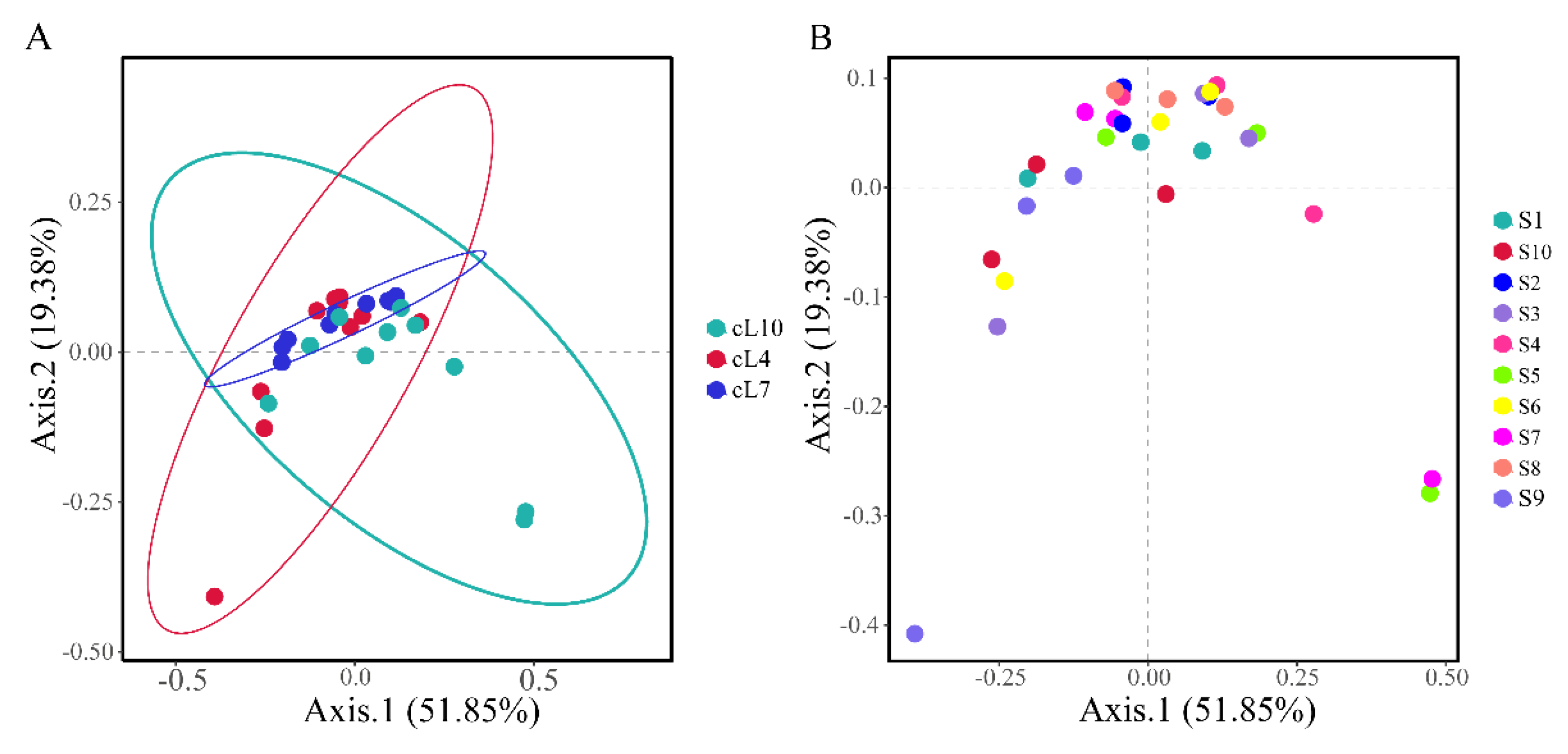
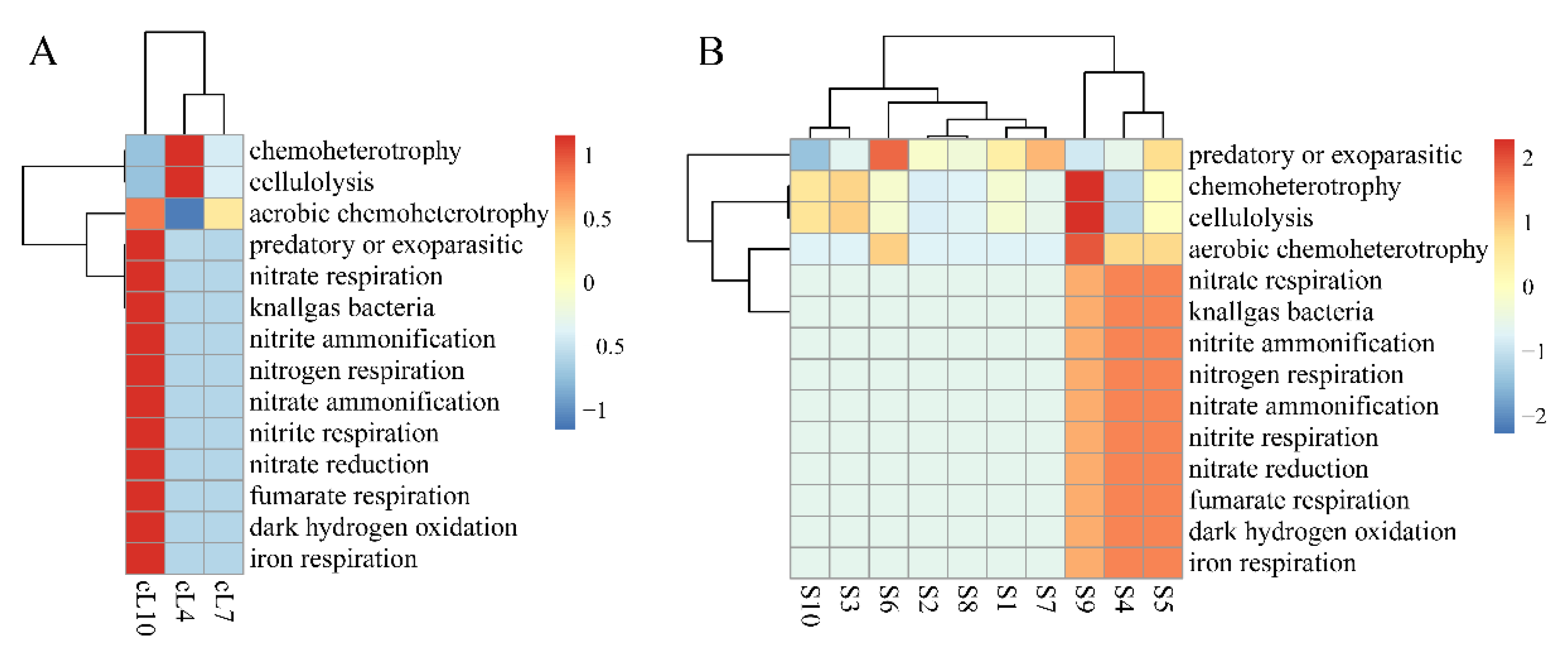

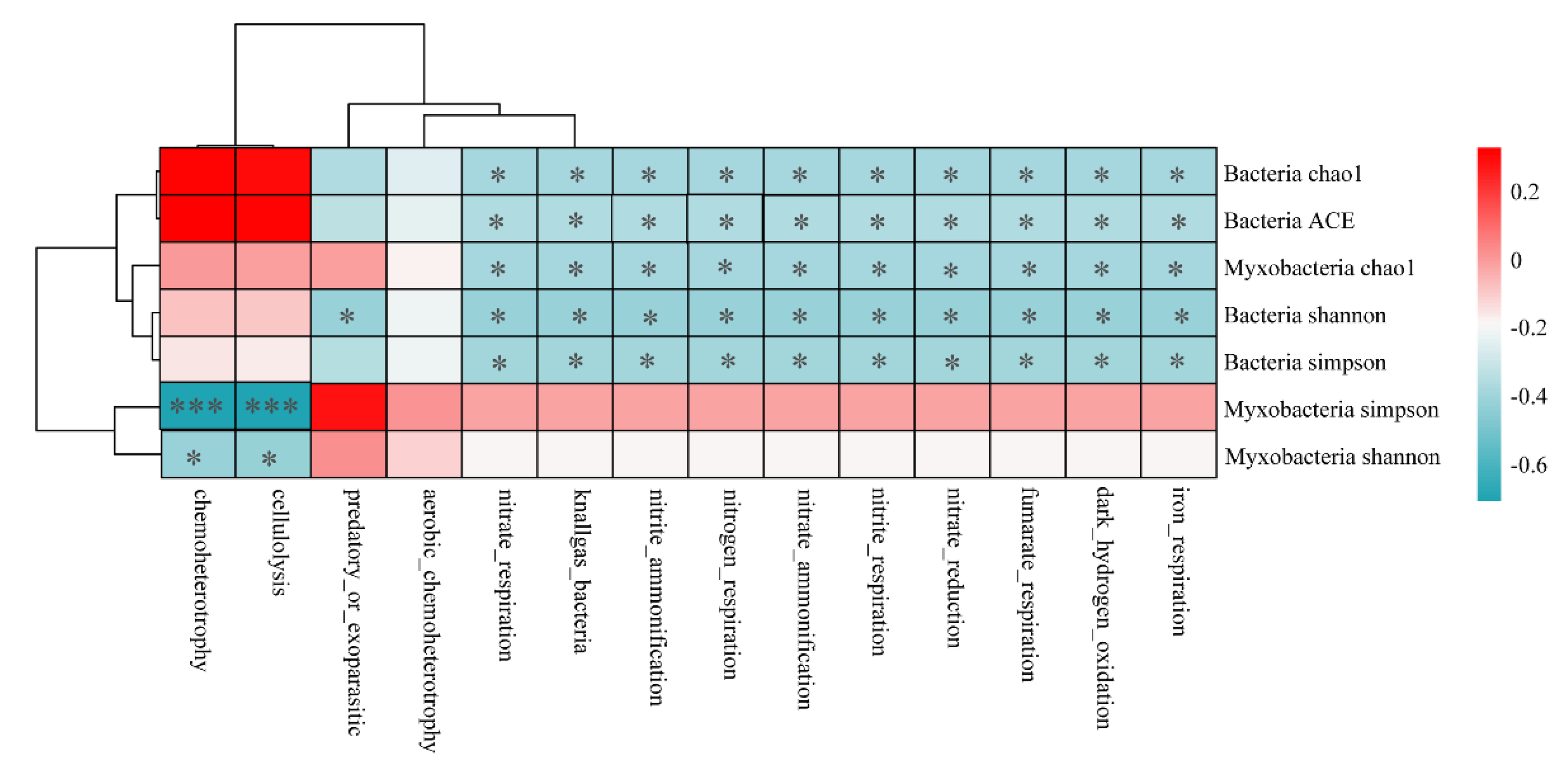


| Season | Nodes | Edges | Degree | Network Distance | Density | Positive Correlation (%) | Negative Correlation (%) | Modularity |
|---|---|---|---|---|---|---|---|---|
| April | 29 | 75 | 2.856 | 2.764 | 0.185 | 74.67% | 25.34 | 0.419 |
| July | 24 | 32 | 1.333 | 2.524 | 0.116 | 65.63 | 34.38 | 0.574 |
| October | 25 | 37 | 1.480 | 2.572 | 0.123 | 91.89 | 8.10 | 0.515 |
Disclaimer/Publisher’s Note: The statements, opinions and data contained in all publications are solely those of the individual author(s) and contributor(s) and not of MDPI and/or the editor(s). MDPI and/or the editor(s) disclaim responsibility for any injury to people or property resulting from any ideas, methods, instructions or products referred to in the content. |
© 2023 by the authors. Licensee MDPI, Basel, Switzerland. This article is an open access article distributed under the terms and conditions of the Creative Commons Attribution (CC BY) license (https://creativecommons.org/licenses/by/4.0/).
Share and Cite
Chen, X.; He, B.; Ding, C.; Qi, X.; Li, Y.; Hu, W. Diversity and Functional Distribution Characteristics of Myxobacterial Communities in the Rhizosphere of Tamarix chinensis Lour in Ebinur Lake Wetland, China. Microorganisms 2023, 11, 1924. https://doi.org/10.3390/microorganisms11081924
Chen X, He B, Ding C, Qi X, Li Y, Hu W. Diversity and Functional Distribution Characteristics of Myxobacterial Communities in the Rhizosphere of Tamarix chinensis Lour in Ebinur Lake Wetland, China. Microorganisms. 2023; 11(8):1924. https://doi.org/10.3390/microorganisms11081924
Chicago/Turabian StyleChen, Xuemei, Bo He, Cheng Ding, Xiaoyun Qi, Yang Li, and Wenge Hu. 2023. "Diversity and Functional Distribution Characteristics of Myxobacterial Communities in the Rhizosphere of Tamarix chinensis Lour in Ebinur Lake Wetland, China" Microorganisms 11, no. 8: 1924. https://doi.org/10.3390/microorganisms11081924






